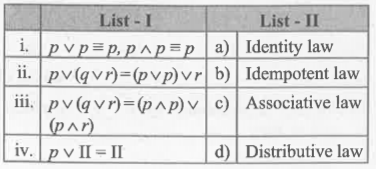In (N,∗),x∗y= max(x,y), x,y∈N, then 7∗(−7) Solution in Tamil
7
−7
0
−49
The correct Answer is:A
Step by step video, text & image solution for In (N, **), x ** y= max(x,y), x, y in N, then 7 ** (-7) by Maths experts to help you in doubts & scoring excellent marks in Class 12 exams.
Updated on:21/07/2023Topper's Solved these Questions
- DISCRETE MATHEMATICS Book:SURA PUBLICATIONChapter:DISCRETE MATHEMATICS Exercise:CHOOSE THE INCORRECT STATEMENT:
Explore 5 Videos
- DISCRETE MATHEMATICS Book:SURA PUBLICATIONChapter:DISCRETE MATHEMATICS Exercise:MATCH THE FOLLOWING
Explore 4 Videos
- DISCRETE MATHEMATICS Book:SURA PUBLICATIONChapter:DISCRETE MATHEMATICS Exercise:ADDITIONAL QUESTIONS
Explore 10 Videos
- DIFFERENTIALS AND PARTIAL DERIVATIVES Book:SURA PUBLICATIONChapter:DIFFERENTIALS AND PARTIAL DERIVATIVES Exercise:5 MARKS
Explore 4 Videos
- INVERSE TRIGONOMETRIC FUNCTIONSBook:SURA PUBLICATIONChapter:INVERSE TRIGONOMETRIC FUNCTIONSExercise:ADDITIONAL QUESTIONS ( 5 MARKS)
Explore 6 Videos
Similar Questions
Which of the following are not statements?
(i) 3+4=8
(ii) Then sun is a planet
(iii) Switch on the light
(iv) Where are you going?
View Solution
The correct match is
View SolutionThe binary operation ∗ defined on a set s is said to be commutative if
View SolutionIf u=tan−1(x3+y3x−y), Prove that x∂u∂x+y∂u∂y=sin2u.
View SolutionFind the domain of the following functions
f(x)=sin−1(2x−3)
View SolutionProperties of logarithmic function Property (5)loga(xn)=nloga|x|(6)lognaxm=mnlogax(7)xlogay=ylogax
View Solution(x+y)n+(x−y)n is equal to
View SolutionProve that the relation R={(x,y):x,y∈Nandx−y is divisible by 7 } defined on positive integers N is an equivlance relations.
View Solutionधन पूर्णांकों के समुच्चय N पर परिभाषित सम्बन्ध R={(x,y):x,y∈N और x−y,7 से विभाज्य है } सम्बन्ध है :
View Solutionयदि (x+y)n के विस्तार में 6 वाँ, 7 वाँ और 8 वाँ पद 112, 7 और 14 हों तो x, y और n ज्ञात कीजिए |
View SolutionIf the arithmetic mean of x and y be xn+1+yn+1xn+yn, then find n.
View SolutionIf Sn=(x+y)+(x2+xy+y2)+(x3+x2y+y2x+y3)+…n terms then prove that (x−y)Sn=[x2(xn−1)x−1−y2yn−1y−1].
View SolutionCompute the product : (xn−y−n)(xn+y−n).
View Solutionयदि N प्राकृत संख्याओं का समुच्चय हो, तो निम्नलिखित सम्बन्ध R का डोमेन क्या है?
R={(x,y) : x+y=7 , जहाँ x,y∈N } .
View SolutionThe number of ways of choosing triplet( x,y,z) such that z≥max{x,y} and x,y,zε1,2,……..n,n+1} is
View Solution
